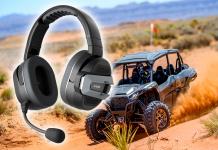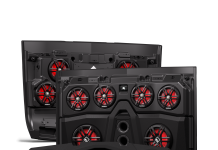Words and images by Guy Pickrell
Cardo, a pioneer in Bluetooth communication systems, brings two decades of experience developing motorcycle helmet comms to recreational off-roading with the new Packtalk Edgephones ORV. Its latest over-ear headphone design delivers all the functionality of the Packtalk Edge helmet system to non-helmet applications, including group intercoms, FM radio, and smartphone connectivity for making telephone calls and listening to music.

Cardo’s second-generation headphone-based system replaces the Packtalk Headphones with a new sleek, robust headset design, built to handle the riggers of off-roading. Its magnetic “Air Mount” accommodates the Packtalk Edge control unit, which uses Cardo’s proprietary Dynamic Mesh Communication (DMC) technology to connect up to 15 people with full duplex intercoms in a wireless, self-contained package.
What’s in the box?
The Packtalk Edgephones ORV have an MSRP of $489.95, which includes a pair of purpose-built, fully adjustable, noise-canceling cans fitted with 40mm JBL speakers. A flexible boom-mounted sound-filtering microphone is removable, and the headphones neatly fold up for easy storage in the supplied carry case. Also included is the Packtalk Edge control unit and a USB-C charging cable.

The Edgephones incorporate a unique magnetic shoe “Air Mount” to hold the Edge control unit firmly in place, and, because it is removable, the same control unit is easily transferred to a helmet using Cardo’s helmet mounting accessory kit, which includes a mounting shoe, Velcro-backed JBL speakers, and dedicated microphone. Current Packtalk Edge helmet system owners can buy a pair of Edgephones without buying another control unit ($149.95).
Testing the Packtalk Edgephones
Cardo says its Packtalk Edge system should afford a range of more than half a mile, is easy to set up, and simple to connect to other users to form communications groups. But, before heading out into the boondocks to test these claims, we needed to charge and update the control units. The first charge took about three hours, and with the free Cardo app downloaded on our smartphones, we connected the Edgephones in a matter of minutes.
Over-the-air updates mean you never have to plug the Edge control unit into a computer and, with the latest software installed, we used the app to set up our fast-dial telephone preferences and some FM radio stations, and to adjust the sound and microphone settings. When it came to connecting the two units, we didn’t feel like reading all the instructions, and after a little trial and error, we managed to create our communication group and were ready to go.

The Edgephones weigh little more than a regular pair of premium over-ear headphones, and their padded, swivel-mounted cans and adjustable padded headband ensure a comfortable (if tight) fit. Their passive noise-canceling is rated to about 15dB and is surprisingly effective at inhibiting a screaming parallel-twin UTV engine. The microphone was equally effective at impeding ambient noise, but only when situated near the mouth.
Intercoms
One of the benefits of using Bluetooth’s robust point-to-point connectivity is that it offers private, simultaneous, full-duplex communication and, at short range, doesn’t suffer much interference. Within line-of-sight, the Edgephones offered clear, hands-free intercom operation up to nearly a mile in range, and thanks to the noise-canceling headphones and sound-filtering microphone, we could speak in our normal voices and still be heard clearly.

However, the geography we traveled through dictated the effective range of the ultra-high frequencies used by Bluetooth. Losing line-of-sight due to solid obstacles, such as a rocky outcrop or a towering dune, inevitably meant a temporary loss in comms. Still, this proved less frustrating than it sounds thanks to Cardo’s DMC architecture.
Rather than relying on Bluetooth’s standard daisy chain connectivity, DMC links users independently of one another, and Its ‘self-healing’ properties mean that members of a comms group that fall out of range will seamlessly reconnect when back in range while staying connected to any group members that remain within their range.
Interface
The Edgephones’ control unit has three multifunctional soft-touch buttons and a clickable wheel to manage all the various functions. This takes some learning and a simpler alternative is to use the pre-programmed voice commands, which are intuitively named and don’t require taking your hands off the wheel or eyes from the trail. Saying “Hey Cardo” followed by the specific command, “Music on,” for example, made life easy. However, we occasionally found that the system would frustratingly confuse “on” and “off.” Recorded verbal feedback helped by confirming our choices and announcing battery status.
Entertainment
The Cardo app enables access to phone features such as making and receiving calls and listening to tunes, all while connected to the group. The JBL speakers offered excellent sound quality, especially after turning on the bass boost in the app settings, which also facilitates sharing music within the group. The Edgephones’ built-in FM radio worked perfectly and, for off-roading families, they allow the kids to listen to their favorite music while still hearing (or ignoring) the group conversation.
Build Quality
The Edgephones are a significant step forward in design and build quality compared to the first-generation Packtalk Headphones, offering a high degree of water resistance and protection from dust. The padding around the cans and headband is replaceable, and the Edge control unit is rated IP67 by the International Electrotechnical Commission, meaning it will withstand complete water immersion at low pressures for short periods. Although ours was a short-term test, the Edgephones’ sturdy design suggests a significant ability to resist wear and tear.
Features
- Bluetooth V5.2
- FM Radio with six presets and RDS
- Supports Intercom groups of up to 15 riders
- Effective comms range of up to a mile
- Effective group range approximately three miles
- Suppotrs simultaneous smartphone and GPS connections
- Dynamic Mesh Communication technology
- Sound by JBL
- Over-the-air software updates
- IP67 Waterproof rating
- USB type-C
- Multilingual status announcements
- Universal Bluetooth connectivity with non-Cardo comms systems
- Full battery talk time: 13 hours
- Charging Time: up to 2 hours
- In-car charging via USB-C
- Standby Time: 10 days
- 2 Year warranty
Should you buy the Cardo Packtalk Edgephones?
For in-car communications, the Edgephones offer unparalleled intercom capabilities and features. Everyone onboard can speak with and hear everyone else while listening to their music or chatting with friends, and virtually all its functions are controllable with hands-free voice commands. Units can be charged on the fly (with a USB socket), and the Lithium-Ion battery offers 13 hours of non-stop use.
For inter-car communications, two-way radios have been the off-roader’s go-to solution for years, and even a relatively cheap walkie-talkie will offer a mile or two of range within line-of-sight. Nevertheless, off-roading rarely offers line-of-sight communication over long distances, and affordable, unlicensed radios aren’t private and don’t permit full-duplex communication (talking simultaneously), which can soon become frustrating with more than two users.
For groups of UTVs with multiple riders traveling together, the Edgephones offer some distinct advantages, delivering a lot of functionality and reliable intercoms over shorter ranges. While larger obstacles that obscure line-of-sight between vehicles will cause a temporary loss of comms, the self-healing DMC connectivity is robust as long as groups remain within three miles of one another.




















